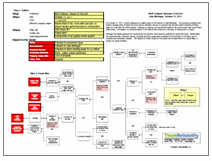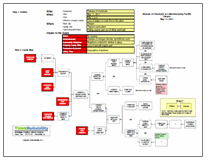On December 16, 1960, two planes collided about a mile above Brooklyn, New York. One plane – United Airlines Flight 826 – was in a holding pattern preparing to descend into Idlewild (now John F. Kennedy International) Airport. The other plane – TWA Flight 266 – was preparing to descend into LaGuardia. Since both airports serve New York City, they are in fairly close proximity. The planes, too, were in close proximity – too close, leading to their collision. In addition to the 84 passengers killed on the United flight (though one would survive for a day) and the 44 passengers killed on the TWA flight, 6 people were killed in the neighborhood of Park Slope, where the United plane landed.
This incident can be outlined in a Cause Map or visual root cause analysis. We begin with determining the impacted goals. First, the 134 total deaths were an impact to the safety goal. The United flight crash resulted in a fire that affected more than 200 buildings, an impact to both the environmental and property goal. The liability for the crash was assigned to both airlines and the government, an impact to the customer service goal. There was another impact to the property goal because both planes were destroyed. Lastly, the labor goal was impacted due to the rescue efforts of the more than 2,500 personnel who responded to the two crash sites.
 These impacts to the goals occurred when both planes crashed after colliding. The planes collided after their flight paths brought them into too close of proximity. The United flight was estimated to be 12 miles outside its holding pattern when the crash occurred, possibly because the ground beacon was not working. The controllers at Idlewild were unaware of the plane’s position as planes were not tracked in holding patterns as it was too difficult to identify individual planes. The planes were unaware of each other. The visibility was extremely poor due to foggy, cloudy, sleety and snowy weather. The United plane had lost the ability to use their instruments due to a loss of a receiver. (The cause is unknown.) Additionally, the controllers at LaGuardia (who were guiding in the TWA flight) were unable to reach the TWA plane to warn them of the close proximity of the United plane.
These impacts to the goals occurred when both planes crashed after colliding. The planes collided after their flight paths brought them into too close of proximity. The United flight was estimated to be 12 miles outside its holding pattern when the crash occurred, possibly because the ground beacon was not working. The controllers at Idlewild were unaware of the plane’s position as planes were not tracked in holding patterns as it was too difficult to identify individual planes. The planes were unaware of each other. The visibility was extremely poor due to foggy, cloudy, sleety and snowy weather. The United plane had lost the ability to use their instruments due to a loss of a receiver. (The cause is unknown.) Additionally, the controllers at LaGuardia (who were guiding in the TWA flight) were unable to reach the TWA plane to warn them of the close proximity of the United plane.
Although comprehensive details are not known about the crash, much of the information used to put together the investigation was obtained from the flight recorder (or “black box”). This is now a main source of data in aviation accident investigations. The evidence in this case was used to divide up liability for the accident very exactly – 61% to United Airlines, 24% to the US government and the remainder to TWA.
To view the Outline and Cause Map, please click “Download PDF” above.









